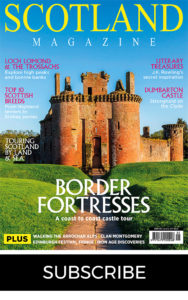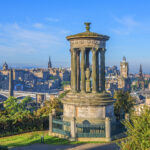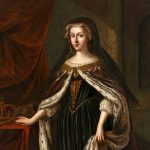MORE FROM SCOTLAND MAGAZINE
The early kings of Scotland: The end of the House of Dunkeld
In the fourth part of our series on the early kings of Scotland, we begin with the king considered the finest monarch Scotland ever produced and end with a queen who was never crowned…
The early kings of Scotland: The end of the House of Dunkeld
King David I
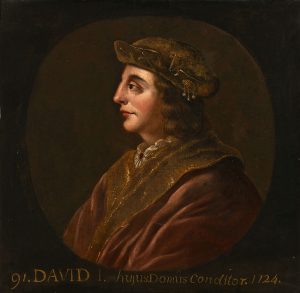
David was the youngest son of Malcolm III and his second wife, Margaret of Wessex. He was born about 1082 and reigned from 1124 to 1153. Having spent a few years at the court of Henry I of England when young, he was determined to introduce more English culture into Scotland, and had married Maud, Countess of Huntingdon. He was also heavily influenced by his mother’s piety and is remembered for founding abbeys, priories and bishoprics (he is venerated in the Catholic Church as a saint), as well as establishing burghs and markets to promote trade and the establishment of a Scottish coinage.
Before he fully ascended the throne, David had shared the kingship of Scotland with his brother Alexander I, ruling southern Scotland. The kingdom of Strathclyde had been gradually absorbed into Scotland, and under David, it was brought fully into the kingdom.
David and Henry respected each other, as David had pledged to support Princess Matilda as Henry‘s successor. However, Stephen usurped the English throne in 1135. David, for all his piety, was very much a man of the sword, and he marched south with an army of 25,000 troops in support of Matilda. No doubt, he also saw it as a chance to expand his influence in England. Stephen immediately sent troops north to halt this advance, and David suffered a heavy defeat in the Battle of the Standard near Northallerton in 1138. He died in 1153 in Carlisle and was buried in Dunfermline Abbey, remembered as one of the finest early kings of Scotland.
King Malcolm IV
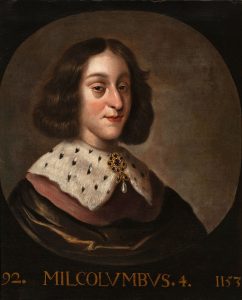
David’s son Henry, Earl of Northumbria, was the heir to the throne, but died in 1152, a year before his father died. This meant that Henry’s son Malcolm (known as ‘Malcolm the Maiden’) became heir apparent. He was 12 years old, so was placed in the care of Donnchadh, Earl of Moray, until Malcolm’s coronation in Scone the following year.
Malcolm reigned until his death in 1165, but it was a troubled reign of rebellion and revolt. He unwillingly surrendered his grandfather’s gains in England, and Scotland was riven with unrest as the nobility jockeyed between them for power and preferment.
Malcolm died aged 24 without producing an heir. Later historians could not agree about his reign. Some claimed he had the makings of a great king, while others called him weak and neglectful of his kingdom.
William I
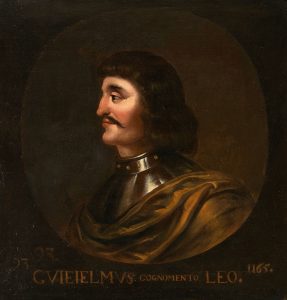
Known as ‘William the Lion (or ‘Lyon‘), William I was Malcolm IV’s brother. He ascended the throne in 1165 and died in 1214. He was unlike Malcolm, being broad-shouldered and, in his youth at least, brash, impetuous, and foolish. After he became king, he spent some time in Henry II’s court in London before they fell out. At Alnwick he was captured by Henry II’s troops and taken to in France, where he was forced to accept the Treaty of Falaise of 1174, which restricted the power of the Scottish nobility, and handed over many Scottish castles to England. It also gave Henry the right to choose William’s wife.
This was humiliating for the Scottish nobility. Even though Richard I annulled the treaty in 1189, William paid dearly for its annulment, as he had to hand over a huge sum of money for Richard’s crusading adventures. However, historians acknowledged that in later life he accomplished much by establishing new administrative centres and a formal legal structure. On his death he was interred in Arbroath Abbey.
Alexander II
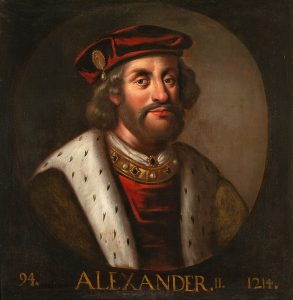
During the 13th century, Scotland gradually developed a sense of nationhood, as it embraced English customs while still retaining a unique Scottishness. It also became more aware of its place as an important European monarchy, and Scottish merchants, scholars and soldiers were visiting and even settling in European countries. Of all the early kings of Scotland, King Alexander II nurtured this trend.
He was William I’s son and reigned from 1214 to his death in 1249. England’s influence is seen in his first marriage to King John’s daughter, Joan of England. The ceremony took place in York Cathedral when he was 23 and she was 11. She died in 1238, and a year later Alexander married Marie de Coucy, who was of the bloodline of the powerful French House of Capet, which raised Alexander’s standing in Europe. Alexander briefly pacified the western seaboard of Scotland and later put down a revolt in Galloway, which brought further prosperity to the already-rich Lowlands. This prosperity soon found its way into the Highlands, shown by the number of Scottish cathedrals being founded there. During his reign, Berwick-upon-Tweed, at that time Scottish, became a major trading port, with England looking on enviously. Alexander died in 1249 and was buried in Melrose Abbey.
Alexander III
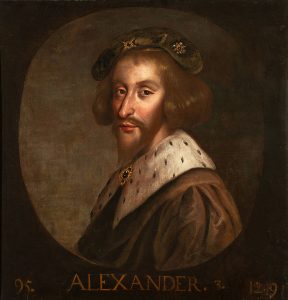
Alexander III was crowned at Scone in 1249, when he was 7 years old. His father was Alexander II, and his mother was Alexander’s second wife, Marie de Coucy. He was born in Roxburgh Castle, and his minority was not a peaceful one.
Two factions, one led by the Earl of Monteith, and the other led by Alan Durward, Judiciar of Scotland (the forerunner of today’s Lord President of the Court of Session) vied to control the country. Durward eventually won the day. In 1263 King Haakon IV of Norway had tried to reassert his authority on Scotland’s west coast. However, he was defeated by Alexander’s forces at the Battle of Largs, in present-day Ayrshire. Alexander then negotiated the Treaty of Perth with Norway, which gave Scotland supreme authority over the Western seaboard.
Alexander’s marriage to Princess Margaret of England took place in York Cathedral in 1251. Her father was King Henry III, and in this marriage, Henry saw his chance. He demanded homage from Alexander as his overlord, which Alexander ignored.
The most important event in Alexander’s life was undoubtedly his death. His wife Margaret died in 1275. However, according to the Lanercost Chronicle (written in the Augustinian Priory of Lanercost in Cumberland) he was never without female company. All three of his children had died, and the succession to the throne was in jeopardy. So, he decreed that his three-year-old granddaughter, known as the ‘Maid of Norway’ should be his heir presumptive.
But he needed a male heir, and in 1285 married Yolande de Dreux, a French noblewoman (also from the House of Capet) to produce one. In 1286 he was staying at Edinburgh Castle, and was determined to return to his new wife, who was in Kinghorn in Fife, in the evening. He was cautioned against this because of stormy weather, but he ignored the advice.
After crossing the Forth with his entourage, his horse stumbled after he had separated from them, and he plunged to his death over a steep embankment. A monument now marks the spot. Alexander was buried in Dunfermline Abbey. Consequently, Margaret of Norway was now heir to the Scottish throne. The House of Dunkeld had come to an end.
Margaret of Norway
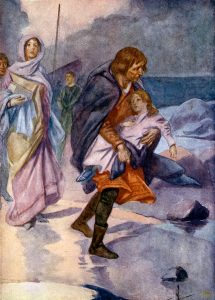
Historians have a problem with Margaret (or Maid) of Norway. Was she a true queen, as her coronation never took place? The question continues even today. Margaret was the daughter of King Eric II of Norway and his wife, Margaret of Scotland, one of Alexander’s daughters, who died in childbirth. She was declared heir to the Scottish throne, as the last surviving descendant of Alexander and she was of the House of Sverre, which only lasted four years.
In the summer of 1290, she and her entourage set sail from Norway. Plans had already been made for her to marry a son of Edward I of England. But en route to Scotland, she took ill and died. She was taken off the boat at Orkney (at that time part of Norway) and from there her young body was taken back to Bergen for burial. She was only seven or eight years old. Margaret’s death threw the whole of Scotland into turmoil, with factions (the main ones being the Balliols, Comyns and Bruces) fighting for supremacy in the kingdom, of which Edward I of England took full advantage when trying to subjugate the Scots.
Our series on the early Kings of Scotland will continue in the next issue of Scotland. Get your copy of October/September issue, here.
The real Macbeth and the House of Dunkeld: Early Kings of Scotland

SCOTLAND MAGAZINE
Published six times a year, every issue of Scotland showcases its stunning landscapes and natural beauty, and delves deep into Scottish history. From mysterious clans and famous Scots (both past and present), to the hidden histories of the country’s greatest castles and houses, Scotland‘s pages brim with the soul and secrets of the country.
Scotland magazine captures the spirit of this wild and wonderful nation, explores its history and heritage and recommends great places to visit, so you feel at home here, wherever you are in the world.
